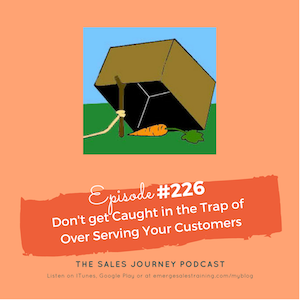Hi. You’re listening to The Sales Journey Podcast, episode number 226: Don’t Get Caught in the Trap of Overserving Your Customers. This is Joelle, and I’m one of the sales and leadership coaches with Emerge Sales Training. For those of you new to the podcast, this is the podcast for network marketers who want to uplevel their sales and leadership skills while being a good human. Our coaching team releases new episodes every Wednesday and Saturday. We know you are going to want to have access to our amazing coaching team. We have free training available for you to make closing sales an enjoyable process for you and your customers or to make recruiting an enjoyable process for you and your potential business builder. Sign up at emergesalestraining.com/freetraining.
Happy Saturday, everyone. In today’s podcast, I’m going to talk to you about the potential trap that salespeople get into in overserving their customers. I’m going to give you some strategies that will help you reach out to people to build your customer base and create new sales and have new sales appointments.
Before we get into the podcast, I want to share with you where this concept of overserving your customers came from. In preparing for this, I was reading the book called New Sales Simplified by [Mark/Mike, inaudible 00:01:31] Weinberg. In this book, he talks about, mainly what’s in the title, new sales. New sales is creating new business, creating new customers and really what the focus of a salesperson should be, which then comes the concept of overserving your customers and what does that mean. This is a touchy subject, and he even says so in the book.
The reason why it’s touchy is because of this: There’s a difference between overserving your customers and following up with your customers. He is not saying do not follow up with your customers. Customer retention is very important. It is a step in the sales assembly line that we teach here at Emerge, and it’s important for network marketers to secure long-term income and repeat business, so it absolutely is important.
The point that he is trying to bring to awareness is this: It is a lot easier to call someone you know, call someone you have an existing relationship with, that knows about your product or service and talk to them, and have a conversation with them. Maybe they’ll purchase something else. Maybe they won’t, but the comfortability in that conversation is much greater than reaching out and prospecting to build new business. That’s what he’s talking about, in terms of being comfortable.
New sales is hard stuff. That can be a little less comfortable, and so we can gravitate toward customer retention and followup more than we gravitate toward new business. That’s my first point, is always look at your planner and look at your activities to see, are you gravitating towards one or the other? There should be a balance, and that balance will give you consistent results. Just be cognizant of that.
Later in this podcast, I’m going to talk to you a little bit more about those strategies and things to say, to reach out to those people that you may not have invited for an appointment. Be cognizant of that. Just be aware.
Now, I’m going to give you some verbiage and some strategies to reach out to people that, one, you haven’t reached out to, to schedule an appointment, for whatever reason. Then, secondly, what you should do or what you can say if you have seen somebody around. They’re not really a friend, but how do you bring up your business if you don’t have that close relationship with them.
The first thing I want to talk to you about is getting new business and building your customer base by going through your contacts on your phone, your Facebook friends. Scroll through the contacts in your phone. I know I have a ton of people in my phone that I worked with in corporate America that I haven’t really talked to in a long time. If you’ve got distance, like time has separated you, right? You haven’t talked to that person in some years, but they’re still in your phone. There can be some apprehension when you’re reaching out to them. It’s hard.
There’s two things that I want to share with you today that are really going to make a big difference in doing that. One, when you reach out to them, you want to reach out to them and acknowledge the awkward. This step is so important. I’m going to give you an example of what it is here in just a minute.
Acknowledging the awkward is very important because it helps you verbalize the feelings that you’re having at that moment to that person so that it doesn’t impact your appointment setting ability or your tone when you’re communicating with that person. When you have apprehension or anxiety or fear, it can impact the way that you communicate to that person, and so that’s what we want to try to mitigate, is getting it out in the open, being honest and saying, “This is what it is,” getting it off your chest, so that that anxiety lessens, and you can then have an effective conversation with that person.
The other piece of this is actually telling them the truth of what’s going on. Number one, acknowledge the awkward to lessen that anxiety and get those feelings out there. Two, tell them the truth about why you’re calling. If you tell them the truth, it feels less icky about reaching out to them and then saying, “Oh, by the way, how are you? I need to tell you about this thing.” You’re going to tell them exactly why you’re calling. That also is very helpful for the person on the other end, so they know what to expect, and they have an agenda. That lessens anxiety on their end, too, so it’s a win-win situation. Acknowledge the awkward is lessening your anxiety, and telling the truth is also lessening your anxiety, as well, but then letting that person know what to expect.
Here’s how that sounds.
“Hey, Sue, is now a bad time?”
They’re going to say, “No, no, it’s perfect.”
You’re going to say something like, “I know I’m calling out of the blue.” That’s acknowledging the awkward because you are calling out of the blue, right? “I know I’m calling out of the blue. I’m calling for a couple of reasons.” Telling them the truth. “I’m calling for a couple reasons: to let you know what’s going on with me, and also to catch up on what’s going on with you. I sell blank,” whatever your product is, “and what I’m doing now is setting up appointments to go over what things you’d want to know about and some of the more popular products. My part takes about 30 minutes. You don’t have to buy anything, but if you see something you like, of course, I’ll help you order it. Is that something you’d be open to? Great! How the heck are you?”
Now, you’re accomplishing both things. You’re putting the business out there. You’re asking them how they’re doing. You’re telling them the truth, and you’re acknowledging that it’s been a heck of a long time since you’ve talked.
What acknowledging the awkward does, too, is … I use humor a lot in my sales career, so I would make a joke in the very beginning and get people laughing. That releases endorphins and dopamine. It makes them feel good. It’s those feel-good hormones when you laugh, so that’s also something that you could do in acknowledging the awkward.
The second thing that I want to talk about today is going to be, how do you bring it up to people that you may see around at the park or that you may see here and there? How do you bring it up, if it doesn’t come up? Now, I’m going to give you some verbiage here, but I also want to say that if it doesn’t come up, it’s okay. You’re just going to chat and be nice and sincere, and eventually, it will come up. If using the approach that I’m going to teach you next isn’t in your comfort zone, that’s okay. It’ll just take a little bit longer to schedule that appointment, but if your intention is to only go to schedule appointments, sometimes people can sense that too, so we want to be … Like I said in the very introduction of the podcast, we want to be a good human.
If you see that opportunity, here’s what you can say, in order to take advantage of that. If you see a person at a park, let’s say, and I have dogs, so let’s be at the dog park. I see this person at the dog park, and this person says to me, “Oh, hey, how are you doing? What’s new?”
I would say something like this. “I have just been doing some yoga lately,” personal stuff, “I’ve just been doing yoga. I’ve just been working. I’ve just been doing some more yoga recently and working on my blank,” your product, “my blank business. I’m glad you asked, because right now, I’m learning how to better serve my customers and focusing more on how to serve them better, so what I’m doing is trying to set up appointments with people I know to get some practice. Any chance you’d be willing to help me out?”
That is a way that you can bridge the gap and talk about, “Hey, I’m doing some yoga stuff, but I’m also working on my business. I’m glad you asked.” That is a really smooth transition into opening up the conversation to people about what you do.
I hope that helps, and I just want to remind you all, as well. Just have a big smile on your face. I know that new sales can be difficult and challenging, and I had a smile on my face when I was talking about giving you those examples of verbiage. Smile big. Be cool. Try out this verbiage to reach out to people you haven’t reached out yet to set an appointment. Maybe, as you get more comfortable, you can bring that up in conversations as you’re out and about.
Thank you for listening to this podcast. To sign up for one of our free trainings on closing or recruiting, go to emergesalestraining.com/freetraining. If you enjoyed today’s podcast, be sure to share it with your friends and leave us a review in iTunes, because it’s not nice not to share. Have a great day.

